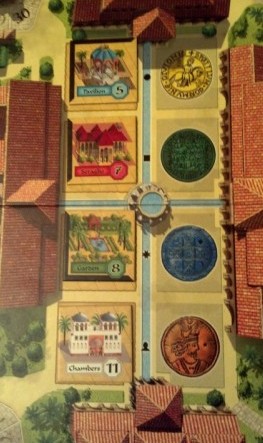Let’s be frank on this one: it’s uncommon to make a game set in the 1200s, let alone one that doesn’t involve The Crusades, Genghis Khan, Frederick II, or the Magna Carta.
And yet here we are with one winning the covetous Spiel des Jahres award*. Why? Well, because Spain back then was clearly a really fun place, right?
Just kidding – it actually was full of your typical medieval death & destruction.
No, it won the award justly because the game transcends its humble concept, and ends being both enjoyable and simple without sacrificing one trait for the other.
The Premise
Players are master builders setting upon the expansion of the great Alhambra palace in 13th century Spain. The greatest craftsmen (you and your fellow players) are competing for the honor to build it, and you must demonstrate your skills efficiently so as to be the one chosen at the end.
The Rules
Each player is given a building tile representing their area’s center location. This is placed in front of them, and all future building tiles that they receive will be placed adjacent to this tile. They are then given currency cards, each with a different color and value. These cards comprise their starting hands. Four currency cards are also placed on the main board into the currency pool. Building tiles are chosen randomly, and at setup, four of them are placed in the colored-coded market slots on the game board. Each market slot corresponds to a particular color of currency, and building tiles in that market slot can only be purchased by the matching currency. Additionally, each of the building tiles also has a color (the building type) and a number (the cost to purchase it). Some also include black borders on one or more sides, depicting “walls”.
The center board also has a point track that will keep score for each of the 3 scoring sections of the game.
Turn structure is rudimentary. Each player has the option to:
1. Pick up currency
2. Buy a building for their area
OR
3. Rearrange their purchased building tiles.
If someone buys a building using exact change (i.e. “I’m buying that $4 Garden with $4), he takes another turn. Each building type (Garden, Seraglio, Tower, etc.) is worth a certain amount of points, and the object is to have more of each building types than your opponents. Scoring is done at three points during the game. The game ends when the building tiles available run out. The player with the highest score wins.
No really, it’s actually that simple.
There are several additional rules outlining tile placement and scoring, but they aren’t complicated. Dealing with the “wall” segments is easily the most complicated part, but everyone catches on to that pretty quickly. (Essentially with walls, you are making sure the black lines connect to other black lines when placing tiles.)
The Stroop Test
It won’t be the rules that trip people up. For new players, it’s the overlapping color-coded systems. The currency comes in four colors (Blue, Green, Orange, and Yellow). These colors correspond to the building market slots, as described above. However, two of the six building types are also Blue (Pavillions) and Green (Gardens). For newcomers, or people not fully paying attention, this is an area of potential confusion. We assure you there will be more than one occasion when someone will attempt to buy a Blue building from the market with Blue currency, even though the building is actually in the orange market slot. This could have been solved by utilizing other color choices, obviously, and we hold out hope that a reprint someday deals with this.
However, it does say something when color choice is the only strike against the game.
Godzilla-Proof
It’s true: the premise of the game happens centuries before fear of a genuine Godzilla attack. However, the game itself keeps players safe from aggressive tactics. To that end, Strikers may not enjoy the civil tone and near retribution-proof mechanics the game embodies. Yes, there is a goal – have the most valuable city and win – but given that there’s very few ways to interfere with other players and/or the randomness of the tiles, the desire to win may not be enough to keep a Striker interested.
Daredevils could also fall by the wayside. The general strategy may not vary enough to keep them fulfilled creatively. On the flip side, the modest rule difficulty and city-building theme will find a natural home with Socializers and Architects, respectively. Tacticians who enjoy some nuance and light strategy, such as choosing when to get money versus purchasing buildings or overpaying to prevent another player from getting a sought-after tile, will like this as well. Those that prefer über rules complexity need not apply, however.
Coffee Table Games
Essentially, Alhambra is a great gateway game that isn’t Settlers of Catan. The rules are effortless, you can engage with other players in a relaxed setting, and the game is such that experienced players don’t have an overwhelming advantage. If you can count and know basic colors, you can play this game.
It also draws a lot of parallels to Carcassonne for being a Coffee Table Game. These are games with a casual atmosphere that allows you to be social without having to heavily strategize between your turns. They’re also not terribly long, and yet they’re still rewarding to play. Moreover, in Carcassonne, you win and lose generally by how you play your farmers, and that tactic always distinguishes newbies from the veterans. In Alhambra, there aren’t any hidden veteran stratagems to face, and this makes for a highly preferential situation for all parties.
The Takeaway
Alhambra didn’t win the Spiel for nothing. The game combines the thematic charm of building your own medieval palace with basic directions that can be learned in five minutes. And the game works. It allows both gamers and non-gamers alike to play casually while avoiding the typical pitfalls involved in mixed parties. Alhambra doesn’t pretend to be any more than a light-hearted game for most demographics, and in that it succeeds. If you’re looking for a good easy-going tile game to add to your collection, or a decent gateway option to have around, this game won’t disappoint.
*Technically Caylus won a Special Spiel, but we’re not here for Caylus, are we?
![]()
Cardboard Republic Snapshot Scoring (Based on scale of 5):
Artwork: 4
Rules Clarity: 5
Replay Value: 4
Physical Quality 4
Overall Score: 4
![]()
You can discuss this article over on our forums!


